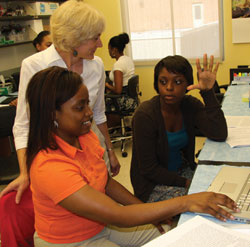Funding from NSF and NIH
 Lizabeth Allison's lab has received steady support since 2001 from not one,
but two federal funding sources.
Lizabeth Allison's lab has received steady support since 2001 from not one,
but two federal funding sources.
Her most recent grant was for $204,105
in June from the National Institutes of Health. She also has received ongoing
funding from the National Science Foundation. Allison's investigation of nuclear
transport is basic science research that has strong clinical potential for
cell-based maladies such as cancer and thyroid hormone disorders, making her
work important to both funding agencies.
"In order to run the lab I need substantial funding and the NIH grants are not quite enough and the NSF on its own wouldn't be enough either. But the two together make a very nice package," Allison explained. The NSF grant is in its second renewal, while the NIH grant is in its third renewal. When she prepares grant applications, she divides the major research objectives so that the NIH funding is applied to the export pathway and clinical implications, while the NSF is focused on the import pathway and more general biological implications. The arrangement has been win-win for the government funding agencies and for the College alike.
"The program director of NIH and the program director with NSF understand entirely the synergy between them," Allison said. "They understand that if I'm buying a bottle of sodium chloride off the NIH grant that some of that might get used for the objectives of the NSF grant. Everybody's gaining a lot in terms of their educational training, as well as the research that we're publishing. I think they see it as worth both agencies' funding to keep it going."
Allison has opened her new lab in the Integrated Science Center to research groups from Hampton University led by Assistant Professor Cornelius Bondzi, who is a collaborator on the aggresome project, and Assistant Professor Shantá Hinton. Hinton and her students are collaborating with Allison's lab, focusing on stress granules, another cytoplasmic complex similar to aggresomes.
"One of the nice things about having funding from NIH and NSF is that it means you can develop a facility that can be used by other institutions that may not have as many resources," Allison said. "We have this really great location for people to come and do science and interact with each other."